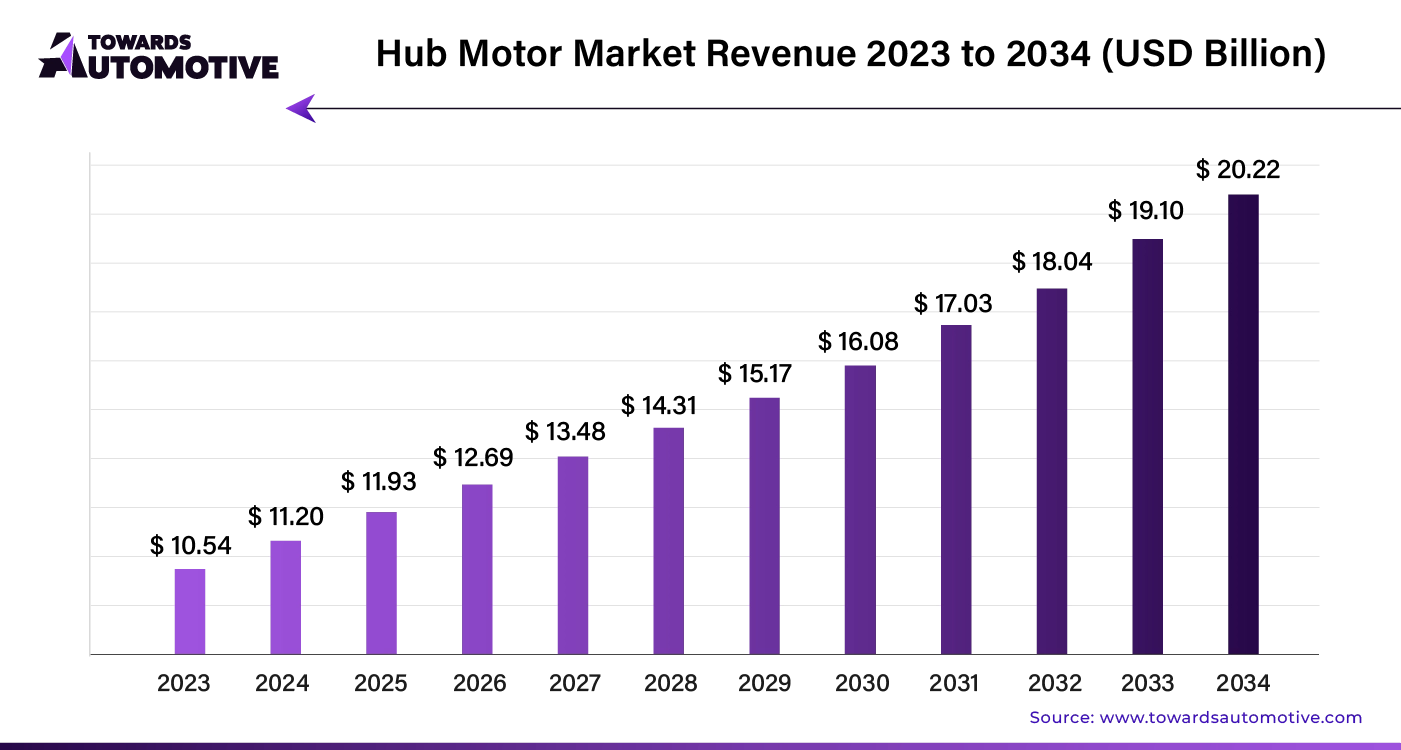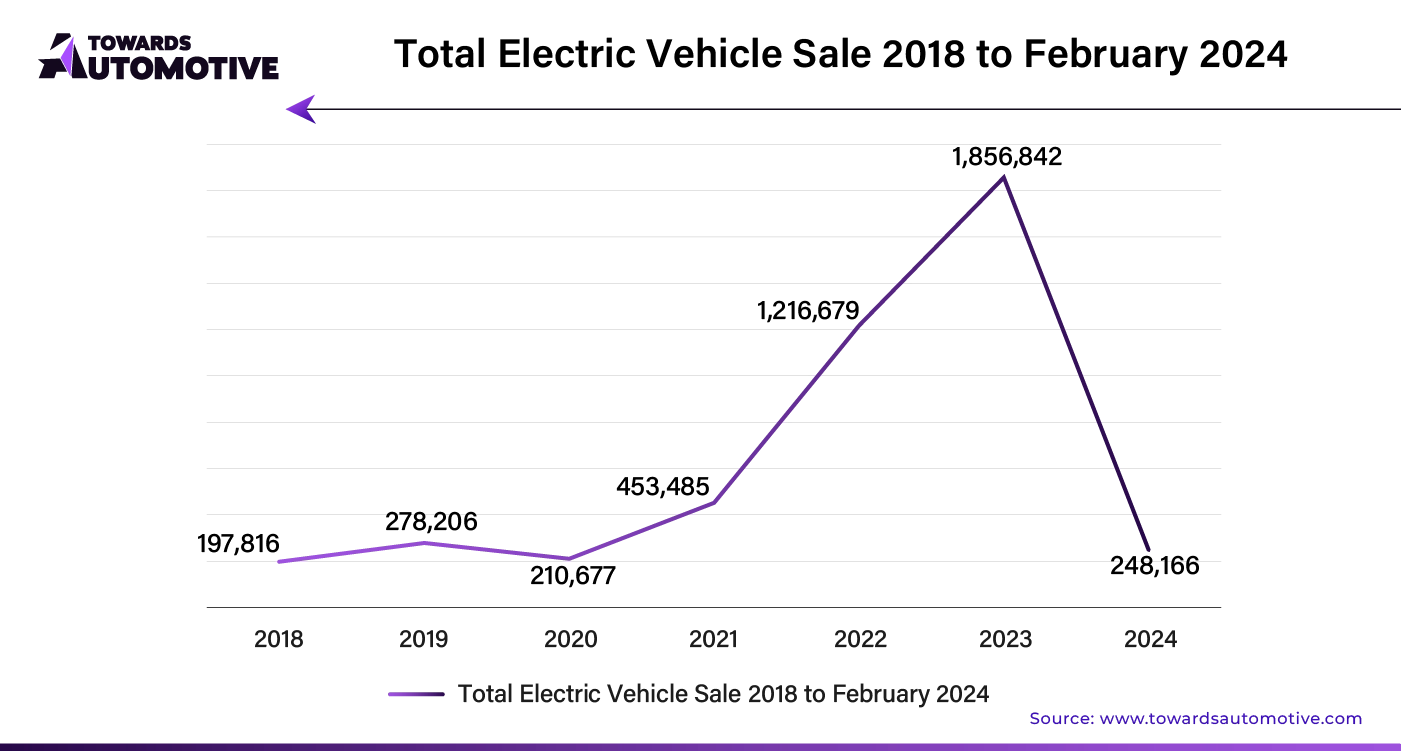April 2025
The global hub motor market size is calculated at USD 11.20 billion in 2024 and is expected to be worth USD 20.22 billion by 2034, expanding at a CAGR of 6.45% from 2023 to 2034.

Unlock Infinite Advantages: Subscribe to Annual Membership
The growing demand for convenient and sustainable urban transportation is driving the rise of motorized wheel hubs in electric scooters, bicycles, and other micro-mobility solutions. As more people seek portable and lightweight electric mobility, sales of brushless hub motors—integrated directly into bicycle wheels—are surging due to their compact design. The development of hub motor conversion kits with smart, connected features is expected to further accelerate market growth.
The global hub motor market is experiencing significant growth, driven by the increasing demand for electric mobility. Automotive manufacturers are receiving strong support from national and international organizations, with substantial investments directed toward advancing hub motor technology. Supportive regulations and incentives in progressive countries are further fueling this trend.
Advancements in high power density battery technology are enhancing the efficiency of in-hub electric propulsion systems, making them more popular. However, the limited availability of lithium and rising costs of lead-acid batteries may pose challenges to market growth in the future. The automotive market valued at USD 4,070.19 billion in 2023, is experiencing growth and is projected to surpass USD 6,678.28 billion by 2032, with a significant CAGR of over 5.66%.
AI integration is set to significantly enhance the growth of the hub motor market. By leveraging AI, manufacturers can optimize production processes, improving efficiency and reducing costs. AI-driven predictive maintenance will minimize downtime by identifying potential issues before they become critical, ensuring continuous operation and extending the lifespan of hub motors.
AI also enables advanced data analytics, allowing companies to better understand market trends and consumer preferences. This insight will drive product innovation, enabling the development of more efficient, high-performance hub motors tailored to specific market demands. Additionally, AI-powered automation will streamline supply chain management, reducing lead times and ensuring timely delivery of components.
As AI continues to evolve, its role in the hub motor market will expand, leading to smarter, more reliable products and creating new opportunities for growth. The integration of AI will not only improve product quality but also enhance customer satisfaction, further fueling market expansion.
The supply chain in the hub motor market operates with precision to meet the increasing demand for electric vehicles. Manufacturers source raw materials such as copper, magnets, and steel from reliable suppliers, ensuring quality and consistency. These materials are then transported to production facilities, where advanced manufacturing processes transform them into high-performance hub motors.
Logistics companies play a crucial role, efficiently handling the distribution of components to various assembly plants worldwide. Once assembled, the hub motors undergo rigorous testing before being shipped to original equipment manufacturers (OEMs). The OEMs integrate these motors into electric vehicles, readying them for market release.
To maintain a steady flow, real-time data analytics are employed to monitor inventory levels and predict demand. This allows suppliers to adjust production schedules, minimizing delays and optimizing costs. Throughout the process, strong collaboration between suppliers, manufacturers, and logistics providers ensures that hub motors are delivered on time and within budget, driving the growth of the electric vehicle market.
This streamlined supply chain not only meets market demands but also enhances the overall efficiency and sustainability of the hub motor industry.

The hub motor market ecosystem comprises several key components, each supported by different companies. Motor manufacturers design and produce the core technology, focusing on improving efficiency, torque, and durability. Companies like Bosch and Yamaha lead in this area, providing cutting-edge motors for electric vehicles. Battery suppliers, including Panasonic and LG Chem, ensure that hub motors receive consistent and reliable power. These companies invest in advanced battery technology to extend range and reduce charging times.
Controller manufacturers, such as Infineon and Texas Instruments, develop sophisticated control systems that optimize motor performance and energy use. Meanwhile, vehicle manufacturers, like Tesla and Nissan, integrate these hub motors into their electric vehicles, ensuring seamless functionality and customer satisfaction. Finally, software developers play a crucial role, with firms like Siemens and Bosch creating intelligent systems that manage the motor's interaction with other vehicle components.
Each company within the hub motor market contributes specialized expertise, driving innovation and market growth. This collaboration among manufacturers, suppliers, and developers forms the backbone of the hub motor industry, ensuring continuous advancements and widespread adoption in the electric vehicle sector.
As the global demand for mobility solutions intensifies, several countries are positioning themselves as key players in the hub motor market. South Korea is at the forefront, with a projected compound annual growth rate (CAGR) of 8.7% from 2024 to 2034. The country’s emphasis on enhancing personal mobility through two-wheelers and three-wheelers with hub motor systems is fueling this rapid growth. Additionally, South Korea's adoption of micro-mobility solutions aimed at reducing urban noise is driving the market, which is expected to reach US$ 1.5 billion by 2034.
Japan follows with a strong 8.1% CAGR, supported by a strategic focus on reducing the costs of hub motors. Japanese manufacturers are advancing the development of high-torque, low-maintenance hub motors using cutting-edge, lightweight materials. These efforts are increasing the appeal of electric hub motors and motorized wheel hub drive solutions, particularly in urban areas. The Japanese hub motor market is anticipated to reach US$ 2.4 billion by 2034.
The United Kingdom is also demonstrating significant growth, with a CAGR of 7.3% projected through 2034. The country's strict environmental regulations and the growing popularity of e-scooters and e-bikes are key factors driving this growth. As environmental sustainability becomes a priority, the use of hub motors in electric skateboards and other personal mobility devices is on the rise, pushing the market value to an estimated US$ 850 million by 2034.
China remains a dominant force in the Asian market, with an expected CAGR of 6.8%. The growth is driven by the country’s expanding electronics sector and government initiatives that encourage rural populations to adopt electric mobility solutions. Chinese manufacturers are also focusing on integrating advanced electronics into hub motors to enhance communication and control capabilities. By 2034, China’s hub motor industry is forecasted to reach US$ 3.4 billion.
In the United States, the hub motor market is expected to grow at a steady 6.9% CAGR. The market is forecasted to reach US$ 3.8 billion by 2034, propelled by technological advancements in geared hub motors and battery materials. These innovations are enabling the creation of more efficient and long-range electric vehicles, catering to the high expectations of American consumers.
The pedelec segment is currently the fastest-growing product type in the hub motor market. With a projected compound annual growth rate (CAGR) of 6.4% from 2024 to 2034, this segment is outpacing other direct-drive hub motors. The rise in popularity of pedelecs is fueled by the increasing dominance of electric two-wheelers, alongside growing awareness of their practicality and health benefits.
On the sales channel front, Original Equipment Manufacturers (OEMs) are leading the market, capturing the majority of hub motor sales. The sales of in-wheel hub motors through OEMs are expected to grow at a CAGR of 6.1% from 2024 to 2034. Customers tend to prefer OEMs for their hub motor kits and warranty coverage, while e-bike companies choose OEMs to ensure they meet hub motor specifications and maintain market competitiveness.
In recent years, competition in the wheel hub motor market has intensified, driven by the increasing involvement of industrial equipment manufacturers. Hub motors are becoming crucial components in electric bikes and scooters, attracting new players to the market.
However, specialized hub motor manufacturers stand to gain by partnering with electric vehicle (EV) makers. These collaborations offer opportunities for mass production and wider distribution.
By Product Type
By Hub Position
By Sales Channel
By Region
April 2025
April 2025
April 2025
April 2025
We offer automotive expertise for market projections and customizable research, adaptable to diverse strategic approaches.
Contact Us